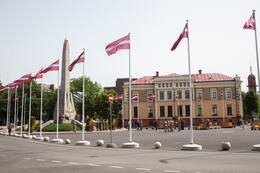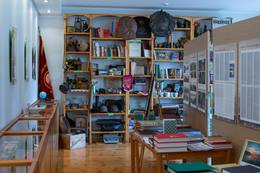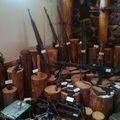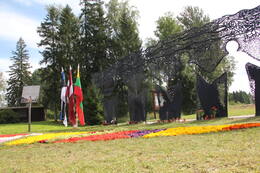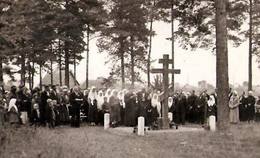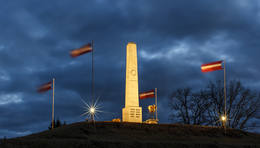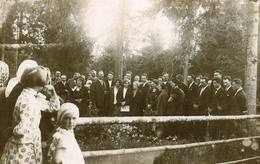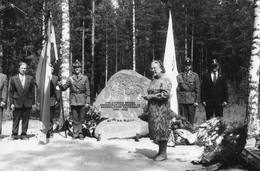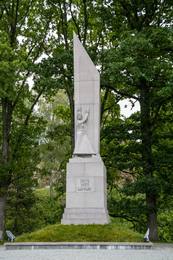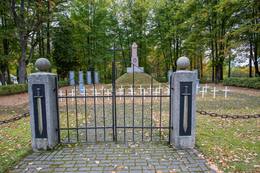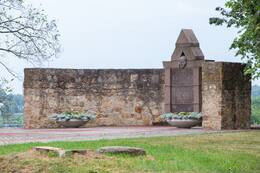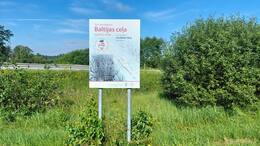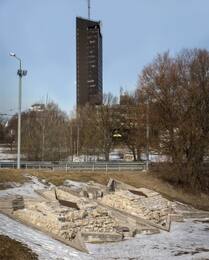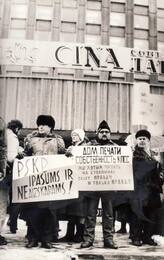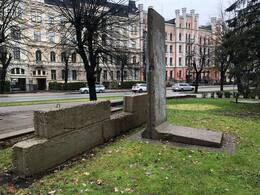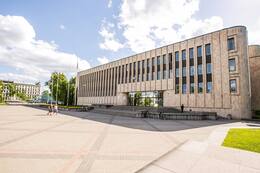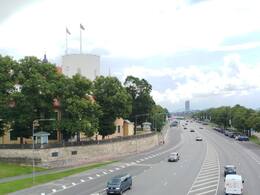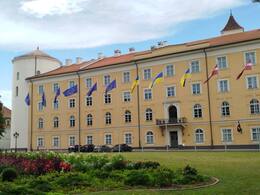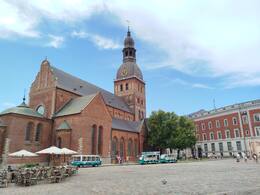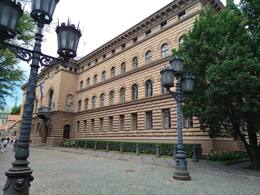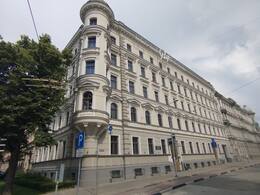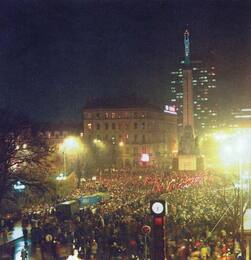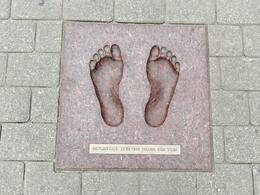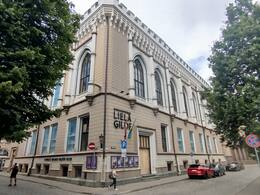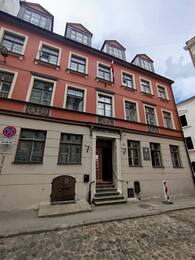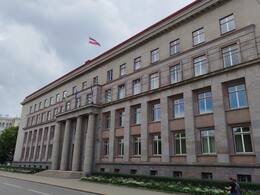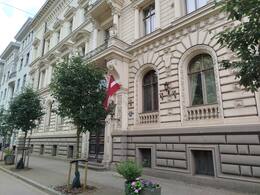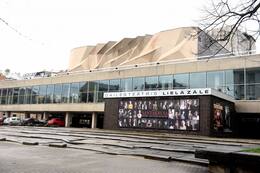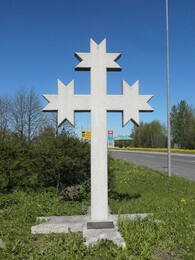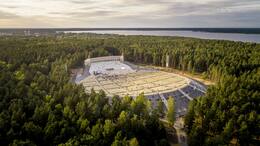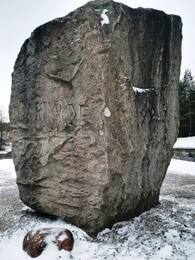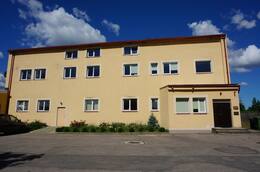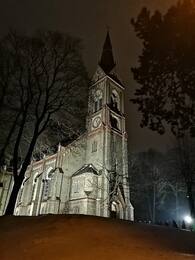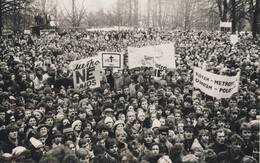The Third Awakening or the Sung Revolution (1987 - 1991)
Restored Independence, IV Soviet Occupation
The Third Awakening or the Sung Revolution — a social movement that led to the restoration of Latvia's independence in 1991.
The Sung Revolution (in Latvia also the Third Awakening) was a period in the history of the Baltic States (Latvia, Lithuania, Estonia) between 1986 and 1991, which ended with the full restoration of state independence in all three countries. At the beginning of the National Awakening movement, public protests by a section of society dissatisfied with the totalitarianism of the USSR in Latvia took place in the summer and autumn of 1987, which coincided with significant dates in the history of Latvia. On June 14, 1987, the public movement "Helsinki-86" organized a laying of flowers at the Freedom Monument in Riga in memory of the victims of the June 1941 deportations, which the authorities tried to disrupt with cycling competitions. The Central Committee of the Communist Party of Latvia and the authorities obedient to it were also against the popular events at the Freedom Monument on August 23 and November 18, 1987.
On June 1 and 2, 1988, the plenary session of the Creative Unions was held in Riga, where Mavriks Vulfsons, a commentator on political events for the newspaper “Cīņa” and television, was the first to openly read the secret protocols of the 1939 Molotov-Ribbentrop Pact and publicize the fact of the occupation of Latvia. On June 14, a public rally was held at the House of Political Education and a march to the Brothers' Cemetery, at the head of which for the first time after World War II the red-white-red flag was carried through Riga. From July 10 to 17, the Folklore Festival BALTICA was held in Riga and other places in Latvia in a patriotic mood. On October 7, a People's Manifestation for the Restoration of the Symbolism of the Latvian State was held in Mežaparks. On October 8 and 9, 1988, the first congress of the Latvian Popular Front was held at the House of Political Education, where publicist Dainis Īvāns was elected the first leader of the LTF.
On May 31, 1989, the LTF board called for a discussion on the full independence of Latvia. On July 28, the Supreme Council of the Latvian SSR adopted the Declaration on the Sovereignty of the Latvian SSR, in which the legislation of the Latvian SSR was declared superior to the legislation of the USSR. On August 23, a popular action “Baltic Road” took place against the Ribbentrop-Molotov Pact and its consequences, when about two million people, holding hands, formed a human chain of about 670 km long for at least 15 minutes, connecting the capitals of the Baltic states. On October 7 and 8, 1989, the 2nd Congress of the LTF was held, which declared the course towards the restoration of the independence of Latvia.
On March 18, 1990, elections to the Supreme Council of the Latvian SSR were held, in which the candidates nominated by the Latvian Socialist Revolutionary Party received the greatest support. On May 4, 1990, the Supreme Council of Latvia adopted the Declaration “On the Restoration of the Independence of the Republic of Latvia”.
Due to the shooting of civilians near the TV building in Vilnius on January 13, 1991, a Latvian national demonstration took place on Daugavmala, in which about 500,000 people with Latvian national flags participated. Starting from January 13, barricades were built in several places in Riga from reinforced concrete blocks, thus beginning the barricade period in Latvia. The barricade period is a historical designation for the defense measures of the Republic of Latvia restored on May 4, 1990, which were organized in Riga and other Latvian cities from January 13 to 27, 1991. On August 19-21, 1991, the so-called State Emergency Committee took power in Moscow. On August 21, OMON units in Old Riga attacked the barricades near the Saeima building, the Supreme Council of the Republic of Latvia adopted a statement on the full restoration of the Constitution of the Republic of Latvia, ending the transitional state postulated on May 4, 1990.
More information sources
Guntis Šmidhens. The Sung Revolution. National Encyclopedia: https://enciklopedija.lv/skirklis/101078-Dziesmot%C4%81-revol%C5%ABcija
The Sung Revolution. Wikipedia. https://lv.wikipedia.org/wiki/Dziesmot%C4%81_revol%C5%ABcija
Related timeline
Related objects
Victory monument in Cēsis
The Victory Monument to Latvians and Estonians killed in the Battles of Cēsis is located in the city of Cēsis, on Vienības Square. In honour of the participants of the 1919 Battles of Cēsis, on 22 June 1924, the first stone was laid for the Victory Monument as sketched by architect Pauls Kundziņš, using funds donated by the people. During the Soviet occupation regime, on the night of 25 March 1951, the monument was blown up and taken down completely. A monument to Lenin, created by sculptor Kārlis Jansons, stood on the former Victory (Unity) Square from 1959 to 1990. In 1997, Māris Niklass, chairperson of the Cēsis District Council, managed to involve Estonian state institutions in the restoration of the monument. The material needed for the construction of the monument, Saaremaa dolomite, was received from Estonia as a gift. On 22 June 1998, during the celebrations of the 79th anniversary of the Battles of Cēsis, the first stone of the monument to be restored was laid on Vienības Square. A ceremony to unveil the restored Victory Monument took place in Cēsis on 15 November 1998 (author: architect Imants Timermanis). Information about the Victory Monument is available in the ‘Cēsis and the Latvian War of Independence’ exhibit of the Cēsis History and Art Museum, in the New Castle.
Vaidava Parish Local History Permanent Exhibition
Located in the Vaidava Culture and Crafts Center.
An exhibition dedicated to the memory of the deportations of 1949, as well as the participation of the Vajdavians in the barricades in Riga in January 1991, is on display. The exhibition also features evidence of the world wars (mainly printed materials).
Natural and historical objects, manors, history of education, culture, notable people, materials from the collective farm era, household utensils, banknotes, newspapers, magazines about Vaidava parish.
Museum of the National Resistance Movement in Renda
The museum is located a few kilometres from the centre of Renda parish. The exhibit tells about the 50-year-long resistance movement in Latvia: resistance to the first Soviet occupation, resistance to the Nazi German occupation, and the armed and non-violent resistance to the Soviet occupation. The exhibit is located in two buildings. The first building houses evidence of the first Soviet occupation and German occupation. The exhibit showcases a restored barn building where the focus lies on the National Partisan War. Between the two buildings there is a bunker with an authentic layout and trenches used by soldiers. Located near the museum in Renda, excavations, blindages and an obstacle course serve as a training ground for youth guards and anyone interested. Visits must be booked in advance.
One of the largest battles of the national partisans, called the Āpūznieki Battle, took place in January 1946 not far from here. The battle saw the Kabile National Partisan Group overpower much larger forces of the occupying power. Featuring information stands, the battle site is now home to a rest area.
Sculpture dedicated to the Baltic Way
Located at the Unguriņi-Lilli border crossing between Latvia and Estonia.
In the spring of 2009, the municipality of Ķoņi parish, whose territory borders Estonia, in collaboration with metal artist Andris Dukurs, created a sculpture dedicated to the twentieth anniversary of the "Baltic Road".
A nine-meter-long and two-and-a-half-meter-high sculpture with human silhouettes, where you can stand and hold hands in the empty places of the human silhouettes. The idea of the sculpture allows you to expand the dimension of time, and not only remember the chain of living people of 1989, but also gives you the opportunity to become a part of the "Baltic Way" at any time together with the sculpture.
Video about the creation of the sculpture.
The Baltic Way was a unique action not only in the Baltics, but also on a European and even global scale. Never before had the residents of three countries united in a living chain of participants, connecting the capitals of the countries – Vilnius, Riga and Tallinn. The historic event took place on the evening of August 23, 1989, it united about 2 million people. Its purpose was to draw attention and recall 50-year-old events – the conclusion of the Ribbentrop-Molotov Pact. As a result, the two superpowers of that time – Germany and the USSR – redistributed spheres of influence in Europe before the next world war, but the Baltic states lost their independence.
The approximately 600 km long chain of participants in Latvia marked the Baltic Way from Bauska to Riga, further to Sigulda, Cēsis, Valmiera and Rūjiena.
Monument to the Old Believer soldiers who fell for the liberation of Latvia
Located in the Jēkabpils city cemetery.
The monument erected by the Old Believer community to the soldiers - Old Believers who fell for the liberation of Latvia in 1918-1919 - can be viewed.
The Old Believer community included several families whose representatives had participated in the battles of 1918–1919, when the issue of gaining Latvia’s independence was at stake. After the Freedom Struggle, these soldiers were granted plots of land from the free land fund. For example, to the Latvian army officer Nikolajs Lebedevs. In 1935, at the proposal of the chairman of the Old Believer community, teacher Tarasija Makarova (1880–1953), it was decided to erect a monument to the fighters for Latvia’s independence. In the Jēkabpils city cemetery, on a cleared and graveled area, delimited by whitewashed posts, an almost three-meter-high oak cross was erected under a pine tree. Old Believer carpenters processed the wood and created an impressive eight-pointed cross. Following tradition, an explanatory inscription was created on a separate oak plaque at the foot of the cross. In Jēkabpils, in the furniture workshop of V. Lukomskis, an inscription was carved in Russian: “To the soldiers – Old Believers who fell for the liberation of Latvia. God, grant them eternal memory!” Initially, there were no burial grounds in the vicinity of the aforementioned cross – only a pine forest. In the 1950s, the cross was outdated. The then chairman of the Old Believer community, Vasily Yakovlevich Fedotov, received permission in the mid-1960s to restore the memorial site, only on the condition that the monument should not be in the shape of a cross and with the inscription: “For the Liberation of the Motherland”.
The restoration of the monument was entrusted to A. Blumbergs. He polished a large brown stone block in the form of a rectangular memorial stele and engraved an eight-pointed cross and oak branches on its front wall. Under the words: “Eternal memory of the fallen soldiers for the liberation of the Motherland”, the inscription “Jēkabpils Old Believers Community” was polished in much smaller letters. The monument was installed on a solid concrete base. In turn, the previous oak plaque with the inscription was protected by placing it in the church.
Since at the beginning of the Third Awakening, no other monument related to the proclamation of the Latvian state had survived in Jēkabpils. Therefore, on November 18, 1988, the people of Jēkabpils held a moment of remembrance with flowers and candles at the Old Believers' cemetery at the monument to the soldiers who fell in the Latvian War of Independence. Soon, the restored oak plaque returned to the foot of the memorial pillar. Soon, the oak plaque was replaced by a marble one with an identical reproduction of the original inscription. In 2013, at the initiative and project of the Belovodije association, the monument was restored and cleaned.
Monument to the soldiers of the 7th Sigulda Infantry Regiment who fell in the Latvian War of Independence
Located on the shore of Lake Alūksne, on the side of Pskevas Street (Kolberg Street).
On June 22, 1923, the President of Latvia, Jānis Čakste, unveiled a monument to the fallen soldiers of the 7th Sigulda Infantry Regiment. The monument was designed by artist Jūlijs Miesnieks.
The soldiers of the regiment also improved and maintained the area around the monument. The soldiers gathered at the monument on the eve of the regiment's anniversary celebration, when they lit the sacred fire, as well as on the day of the regiment's anniversary after the parade and intercession at the Garrison Cemetery.
In 1940/1941, the Bolsheviks removed and destroyed the plaque, but the monument itself was demolished in 1953 and its stones were built into the corner foundations of the barracks building.
As the Awakening began, the area around the destroyed monument, which was still located in the territory of the USSR occupation troops at the time, was cleaned up in the autumn of 1989. On November 11, a temporary granite memorial was unveiled at the former location of the monument, with the text engraved: "The monument to the 7th Sigulda Infantry Regiment will be restored at this location on November 11, 1989."
Thanks to the initiative of U. Veldre, head of the Alūksne Brothers' Cemetery Committee, restoration work on the monument was begun and the restored monument was unveiled on October 16, 2009.
Unlike the original monument, a cross was created on the obelisk instead of the regimental breastplate. Both reliefs of the monument were forged by sculptor Ainārs Zelčs. Both parts of the 22 original obelisk blocks, which were found on the territory of the Infantry School of the National Armed Forces, and newly made blocks were used for the restored monument.
On June 20, 2019, as part of the centenary events of the 7th Sigulda Infantry Regiment, a memorial site for the regiment's monument and a granite memorial plaque to the fallen soldiers of the unit were unveiled at the foot of the monument hill, engraved with the text: "Your strong spirit always ranks with us...". The memorial site was built with funds donated by the personnel of the Infantry School of the National Armed Forces.
Memorial to the fallen Latvian Legion soldiers and national partisans
Located in the Lubāna New Cemetery in Indrāni Parish.
A memorial site to the fallen Latvian Legion soldiers and national partisans is open for viewing.
The memorial was opened on July 25, 1992. The memorial stone was created by Andris Briezis.
As the Awakening began, in October 1990, Kārlis Doropolskis, a member of the human rights group “Helsinki 86”, received permission from the authorities to begin the reburial of Latvian legionnaires who had fallen and been buried scattered around Lubāna in the summer of 1944, as well as national partisans who had fallen in later battles with the Soviet occupation troops and security institutions, in common mass graves, which were arranged in the new cemetery in Lubāna. In total, 26 fallen legionnaires and national partisans were buried in mass graves.
Freedom Monument in Rauna
The monument, created by sculptor Kārlis Zemdegs, is dedicated to the memory of the members of the Rauna parish who fell in World War I and the War of Independence.
As one of the unrealized variants of the Riga Freedom Monument project, it was unveiled on August 20, 1933. The 3rd President of the Republic of Latvia, Alberts Kviesis, attended the opening event.
The original name of the monument was "ES DŪR" - the motto - the spear turns into a kokle and the people are saved by the spirit of song. The base of the monument is decorated with the words of the hymn composed by Baumaņi Kārlis - "God, bless Latvia".
Before the monument was unveiled in 1933, the people of Raunė, while carrying out landscaping work around the monument, planted an oak alley and placed a capsule with the name of a fallen soldier under each oak tree. Later, in 1937, the names of the fighters were engraved on a white marble slab, which is placed in the church.
During the communist occupation, the inscription "God, bless Latvia" was removed from the pedestal. It was restored when the Revival began in June 1989.
Monument to the soldiers who fell in the War of Independence
Located in Valka on Varoņu Street next to the Forest Cemetery.
A monument to 30 soldiers of the 1st (4th) Valmiera Infantry Regiment who fell in the Latvian War of Independence can be seen.
The monument was unveiled on October 1, 1922. It consists of a figure of an ancient Latvian warrior (“Ancestor”) carved from local reddish granite, placed on a two-part pedestal made of gray granite. The design chosen for the monument was by sculptor Emīls Melders (Miller). Along with Melders, sculptor Vilhelms Treijs also participated in the carving of the monument.
It is the first monument to the Latvian War of Independence created by a professional sculptor, as well as the only one in the interwar period made in the modernist style, using cubist elements.
During the repeated communist occupation in 1951, the monument sculpture was toppled, partially damaged, and buried. The burial grounds were also leveled.
In 1988, as the centenary of the sculptor E. Melders (1889-1979) approached, a study of his works was initiated.
The restored fraternal cemetery, along with the restored monument, was opened on November 11, 1990.
In 2017, eight memorial steles were installed at the fraternal cemetery to the knights of the Lāčplēsis War Order associated with Valkas. They are located on both sides of the monument – four steles on each side.
Monument to those who fell for the Fatherland in 1918-1920.
Located on the side of Rīgas Street, opposite Krustpils Castle.
In Jēkabpils, on the right bank of the Daugava River, the monument “To Those Who Fell for the Fatherland 1918–1920” was erected, a proposal to erect a monument to soldiers who fell in the War of Independence was made by the Krustpils branch of the Latvian Brothers’ Cemetery Committee on June 12, 1923. For the creation of the monument, the Krustpils parish board transferred to the Brothers’ Cemetery Committee on November 12, 1923 a stone part of the monument to Tsar Alexander II near the parish board building, where the monument had been erected in honor of the abolition of serfdom. The Latvian Ministry of the Interior allowed the Krustpils branch of the Brothers’ Cemetery Committee to collect donations. A total of 2,400 lats were donated, 1,200 were missing. They hoped to get them from the bazaar and social evening organized on the day of the monument’s opening.
The project of the monument was entrusted to the architect Aleksandrs Birznieks. The architect's plans were to create a monument from local material - dolomite studs. The volume of the monument was formed by two concentric, massive semicircles of dolomite stud masonry, of which the outer one was lower on the Daugava side, cut into the bank and formed a terrace. In its center was a red brick fire cross. In the center of the main semicircle, as an altar, granite slabs with the text: "To those who fell for the Fatherland 1918 - 1920" and depicting a rising sun over the waves of the Daugava, and framed by Latvian signs, were built. The central part of the monument was formed by the mask of a fallen soldier, sculpted by sculptor V. Treijs. The acting commander of the Latgale Artillery Regiment, Lieutenant Colonel Jākobsons, allowed the use of a square on the right bank of the Daugava opposite Krustpils Castle for the construction of the monument, with the condition that the square remain the property of the Latgale Artillery Regiment.
In 1925, the Krustpils branch of the Latvian Brethren Cemetery Committee concluded an agreement with businessman V. Treija from Riga for the construction of a monument in Krustpils. On July 26, 1925, the foundation of the monument was laid. September 27, 1925 is a holy day for the people of Krustpils. The monument was unveiled with its consecration, performed by the Lutheran pastor of the Krustpils parish, K. Skujiņš. The Minister of War, R. Bangerskis, the commander of the Latgale Artillery Regiment, Colonel Kire, General K. Berķis, etc. participated. 11 cubic limestone studs, which were broken near Asote, were used for the construction of the monument.
In the 1950s, the monument “To Those Who Fell for the Fatherland 1918 – 1920” was partially destroyed – the upper part was demolished – the mask of ancient Latvian soldiers, the inscriptions were smeared, the fire cross sign was destroyed. In turn, already at the beginning of the Third Awakening, activists of the Krustpils branch of the Latvian Popular Front (LTF) included in the resolution at the first LTF district conferences a demand to restore the monument in Krustpils. Already on November 11, 1989, at the place where the monument was located, a moment of remembrance was held, in which the people of Jēkabpils commemorated their Lāčplēšis.
In early 1992, restoration work on the monument began. Granite pieces of the required size and shape are being made at the Cēsis communal enterprise plant. The granite was processed according to the drawings by E. Nīmanis and V. Treikmanis. The technical supervision of the restoration of the monument is carried out by architect Māra Steķe. In Riga, sculptor Inta Berga cast the bronze parts of the monument. All works were financed from the financing of the city of Jēkabpils. The restored monument was consecrated by the then dean of the Jēkabpils and Krustpils Evangelical Lutheran parish, Modris Plāte, and the priest of the Jēkabpils Catholic parish, Jānis Bratuškins, on November 18, 1992.
It was opened in Krustpils on September 27, 1925. The monument was designed by architect Aleksandrs Birzenieks. The inscription "For those who fell even for the Fatherland 1918-1920" is engraved on the monument. The monument was partially demolished by the Soviet occupation authorities in 1941, and completely destroyed around 1950. The monument was restored on November 18, 1992.
Commemorative sign dedicated to the 25th anniversary of the Baltic Way
During the campaign “Baltic Road” on August 23, 1989, people from Kurzeme and Zemgale - Liepāja, Saldus, Dobele, Kuldīga, Ventspils, Talsi, Tukums and their surroundings arrived on the Riga - Bauska highway section. The main task was to achieve the most even distribution of people and continuity of the chain. Where there was not enough arm length, people were asked to use flags, belts, or even jacket sleeves, just so that the blood circulation of community in this artery would not be interrupted. In total, about 400,000 Latvian residents participated in this campaign.
The memorial sign dedicated to the 25th anniversary of the Baltic Way in Ķekava municipality, at the 25th kilometer of the Riga-Bauskas highway near the Ķekaviņa River, was unveiled on August 23, 2014. Its ceremonial opening was attended by the Prime Minister of the Republic of Latvia, Laimdota Straujuma, a long-time employee of the State Joint-Stock Company “Latvijas Valsts ceļi” and a member of the Baltic Way, Uldis Birzleja, and other attendees. In 2014, 10 such memorial signs were erected on the Baltic Way section of Latvia in memory of this event. Four memorial signs were erected in Estonia, and nine in Lithuania. On July 30, 2009, the Baltic Way campaign was included in the UNESCO “Memory of the World” documentary heritage list.
Barricades Memorial "Eyes"
The environmental art object “Eyes”, created by Igors and Ruta Dobičin in 1991 (restored in 2012) in memory of the barricades, is dedicated to the 30 x 60-meter square. Dolomite and concrete pile and paving elements, similar to graphic signs, are placed in the 30 x 60-meter square, forming a cryptogram resembling a stylized “face”. A plaque is built into the symbolic ensemble with the inscription: “Eyes. Dedication to the guards of the Television Center during the barricades in 1991. There is strength in unity”. In 1991, a sculpture by Ojārs Feldbergs “By the Fire” was installed near the LTV building. The two-meter-high sculpture, carved in granite, contains a metaphor for people from four Latvian regions gathering around a common fire.
Television, like radio and the printed press, played a very important role during the Awakening not only as a source of information, but also as a driver of this process. The LTV program “Labvakar” (Good Evening), launched on January 31, 1988, gained immense popularity. It was the first program in Latvia in which Edvīns Inkēns, Ojārs Rubenis and Jānis Šipkēvics spoke about many previously forbidden topics. LTV broadcast live broadcasts from Latvian Popular Front congresses and mass demonstrations, and produced interviews and reports on politically important issues.
During the barricades in January 1991, the LTV building was one of the important objects guarded by volunteers. This was a difficult task, as the building is located in a large and easily accessible area. The barricades participants guarded the direct approaches to the building, as well as blocked the Salu bridge at night. From the Daugava side, the LTV center was guarded by three fishing boats. Remaining intact during the barricades, the LTV building was invaded by paratroopers of the USSR Army and members of the OMON unit during the August 1991 coup. After it was captured on August 19 at 7:30 p.m., the TV stopped broadcasting, but resumed its work after the coup failed and after the Soviet paratroopers left the LTV building on August 21 at 7:45 p.m.
Former Press House building
The publishing house and printing house complex built in 1978 housed the editorial offices of all newspapers and magazines of republican importance. Journalists played a very important role in the course of the Awakening, as their presence in the Press House facilitated mutual contacts and organization. It was here that the Latvian People's Front began to take shape. The idea of the need for such an organization was expressed at the plenum of the Creative Unions on June 1-2, 1988, and already on June 22, Viktors Avotiņš read its first, unpublished manifesto at a meeting of journalists. However, the idea was only realized after the Writers' Union and its chairman, Jānis Peters, became involved in its implementation.
The Press House belonged to the Central Committee of the Communist Party of Latvia, which had taken over and effectively monopolized the publication of all newspapers and magazines of republican significance. All profits from the publishing house and printing house went to the treasury of the Central Committee of the Communist Party of Latvia. During the Awakening, as efforts to restore Latvia's independence intensified, the issue of ownership rights to the Press House also arose. After the adoption of the Declaration of Independence on May 4, 1990, a dual government was effectively formed, as some Latvian institutions refused to submit to the government of the Republic of Latvia. The Latvian government established the Latvian Newspaper and Magazine Publishing House, but the USSR Council of Ministers and the Central Committee of the Communist Party of Latvia led by Alfred Rubiks considered the Press House to be the property of the USSR. The situation escalated in November 1990, when OMON attacks on the Press House took place, but on January 2, 1991, OMON completely took over the Press House and stopped printing publications supporting the LTF, expelling their employees from the Press House.
Demolition work on the Press House printing house began in 2020. The construction of the Press House block is currently underway, which will completely change its former appearance.
Monument "The Wall - Divider and Uniter"
The memorial site at Elizabetes Street in Kronvalda Park was opened in September 1992 after a fragment of the dismantled Berlin Wall was exhibited in Riga. In 1992, it was combined into a single memorial ensemble with a fragment of the concrete wall erected near the Saeima building during the 1991 Barricades and installed in Kronvalda Park at Elizabetes Street, next to the World Trade Center. An altar for laying flowers is attached to the monument with an inscription in Latvian and German: “After the exhibition of the Berlin Wall Museum “Haus am Checkpoint Charlie” in Riga in November 1990, the museum director Dr. Rainer Hildebrands presented this fragment of the wall to the capital of Latvia.”
In 2011, the monument was restored and the territory was improved. An information plaque with text in Latvian, German, English and Russian was installed. The barricade blocks were supplemented with historical inscriptions in Latvian and Russian: “The Berlin Wall divided us, the Riga Wall unites us. Let us only love our neighbor, and pray to God for our enemy.”
Riga Congress Center
The Congress Hall (at that time the Political Education Hall of the Central Committee of the Communist Party of Latvia) was one of the few meeting rooms in Riga where a larger number of people could gather. During the revival, a variety of events were held there - congresses of the Latvian Popular Front, founding events for various public organizations, discussions on history, etc. On June 1-2, 1988, an expanded plenum of the board of the Latvian Writers' Union was held here with the participation of other creative unions, to which the leadership of the Latvian SSR was invited. Many painful problems were discussed, but the effect of a bombshell was created by the speech of the well-known political commentator and 1940s activist Mavriks Vulfsons, in which he declared that there had been no socialist revolution in Latvia in 1940.
On June 14, 1988, a rally was held in memory of the victims of mass deportations at the Congress House. It was the first officially authorized rally, at which both officials (for example, the Secretary of the Central Committee of the Latvian Communist Party Anatolijs Gorbunovs) and representatives of the public (journalists Andrejs Cīrulis, Edvīns Inkēns, a representative of the Environmental Protection Club Valdis Turins, a priest Juris Rubenis, dissident Eduards Berklavs, etc.) spoke. The rally ended with a march to the Freedom Monument. During the march, Konstantīns Pupurs carried the Latvian flag. Many posters at the rally were quite radical, for example, "No — to the histories of Drīzulis and Karaļuns", "No to the kangaroo Voss of our day!" Modris Lujāns held a poster on which were pasted photos of Stalin and Ribbentrop with the caption "Curse on the murderers of the people" and photos of August Voss and other leaders of the Latvian Communist Party with the caption "No to the kangaroos!" A few days later, at the plenum of the Central Committee of the Latvian Communist Party, First Secretary Boriss Pugo condemned certain individuals and groups who “under the guise of reorganization tried to give the rally a distinctly nationalistic, provocative orientation.” A criminal case was initiated against M. Lujāns, but on September 30 the Supreme Court of the Latvian SSR fully acquitted him.
The next turning point in Latvian history was the 1st Congress of the Latvian Popular Front on October 8-9, 1988, which was also held at the Congress House. On December 10-11, the Forum of the Peoples of the Latvian SSR was also held here.
Daugavmala (11. November Embankment)
The Daugavmala or 11 November embankment between the Akmens and Vanši bridges in Riga was the site of popular demonstrations in 1989-1991. The largest of them were the demonstration "Let's prevent threats to the democratization process!" organized by the Latvian Popular Front on March 12, 1989 (200-250,000 people), the demonstration "For an independent Latvia" on November 18, 1989 (600,000 participants), and the Supreme Council pre-election demonstration "Both sides of the Daugav will never be divided" organized by the LTF on March 17, 1990.
On the night of January 13, 1991, Soviet army tanks surrounded the building of the Supreme Council of Lithuania, Soviet soldiers seized Lithuanian TV, radio and telegraph, killing 14 and wounding 110 civilians. At 4:45 AM, LTF Chairman Dainis Īvāns called on Latvian radio to defend the country's most strategically important buildings. At 2:00 PM, a huge demonstration (500-600,000 people) took place on the 11th of November embankment in Riga, protesting against a possible armed coup and actions in Lithuania.
In addition to these large-scale demonstrations, other smaller-scale public demonstrations also took place on Daugavmala. Particularly emotional was the spontaneous gathering of more than 100,000 people on the 11th of November embankment on May 4, 1990, after the adoption of the Declaration “On the Restoration of the Independence of the Republic of Latvia”.
Riga Castle
On November 11, 1988, on Lāčplēsis Day, actor Ēvalds Valters and writer Alberts Bels raised the Latvian national flag on the Holy Spirit Tower of Riga Castle. Thousands of people had gathered on the Daugavmala.
On February 15, 1990, the Supreme Council of the Latvian SSR adopted a law and regulations on the national flag of the Latvian SSR, stipulating that the national flag is crimson red with a longitudinal white stripe in the middle, but on February 27, a solemn ceremony took place when academician Jānis Stradiņš raised the red-white-red flag at the building of the Supreme Council of the Latvian SSR. The Latvian flag was also raised above the buildings of the Council of Ministers of the Latvian SSR and the Riga City Council on that day.
On January 16, 1991, by a decision of the Supreme Council of the Republic of Latvia, the status of the national flag of the Republic of Latvia was restored.
Dome Square in Old Riga
The importance of Dome Square during the Awakening was determined mainly by two circumstances – it was located in the immediate vicinity of the building of the Supreme Council of the Latvian SSR, as well as the fact that the building of Latvian Radio is located on the square. Various actions were held on Dome Square, putting forward demands to the Supreme Council, for example, on July 26, 1989, the Latvian Federation of Labor organized a rally attended by 60,000 people, demanding that the Supreme Council adopt the Declaration of Sovereignty. It was at this rally that the then popular slogan “Something in the past, but in free Latvia” was raised.
Dome Square was the main gathering place for the defenders of the barricades in January 1991, protecting the Supreme Council and the Radio House. The defenders of the barricades warmed themselves by the bonfires. They also stayed in the Radio House and the Dome Church. A first aid station was set up in the church, and services were held. In the evenings, popular rock bands performed on an improvised stage in the square. Every year, events commemorating the barricades are held in Dome Square.
Near the Dome Square, at Krāmu Street 3, there is a museum of the 1991 barricades. On January 13, 2018, the stained glass window “With passion for a free Latvia” by artists Krišs and Dzintars Zilgalvji was unveiled in the Dome Church - a dedication to the 1991 barricades and the independence of Latvia.
Parliament House (Saeima)
The former Vidzeme Knights' House has been the home of the Latvian Parliament since 1922. During the Soviet occupation, a pseudo-parliament - the Supreme Council of the Latvian SSR - was located here. In the elections to the Supreme Council held in March 1990, the main issue was the restoration of Latvia's state independence. This was done in accordance with the position of the Latvian Popular Front, which stated that it was more realistic to do this using the existing power structures of the USSR. In order to win a qualified vote in the Supreme Council, 134 votes were needed.
On May 4, 1990, the Supreme Council of the Latvian SSR adopted the Declaration “On the Restoration of the Independence of the Republic of Latvia”. 138 voted in favor of its adoption, 1 abstained, but 57 deputies who advocated Latvia remaining part of the USSR did not participate in the vote. By adopting the Declaration, the 1922 Constitution was restored in the territory of Latvia, but until the adoption of a new version of the Constitution, its operation was suspended, except for the first three articles of the Constitution. Such a transitional period was determined until the convocation of the Saeima of the Republic of Latvia. May 4 is celebrated as the Day of the Restoration of the Independence of the Republic of Latvia.
On May 15, 1990, opponents of independence attempted to seize the Supreme Council with the help of military cadets dressed in civilian clothes, but the spontaneously organized students of the Polytechnic Institute and the Institute of Physical Culture repelled the attack. The second attempt to attack the Supreme Council was stopped by the militia (the OMON unit, which in June 1990 refused to submit to the government of the Republic of Latvia and became the main strike force of the opponents of independence).
The Supreme Council was one of the most important points of barricade protection in January 1991. The approaches to it were fenced off with reinforced concrete blocks, and these protective structures were there until the unsuccessful coup attempt in Moscow on August 19-21, 1991. Soviet paratroopers and OMON fighters were unable to occupy the Supreme Council, and its deputies continued their work. On August 21, at 1:00 p.m., four OMON armored personnel carriers entered the Dome Square and remained there until 2:10 p.m., trying to intimidate the deputies, who at that time (at 1:10 p.m.) adopted the Constitutional Law on the State Status of the Republic of Latvia (111 deputies voted for, 13 against). This abolished the transitional period established on May 4, 1990 for the de facto restoration of state power in the Republic of Latvia, and Latvia regained full independence. In 2007, a memorial site for the January 1991 barricades was opened near the Saeima building on Jēkaba Street, and in 2000, in honor of the 30th anniversary of the restoration of the independence of the Republic of Latvia, a commemorative plaque was installed next to the main entrance of the Saeima with the inscription: "In this building, on May 4, 1990, the deputies of the Supreme Council adopted a declaration on the restoration of the independence of the Republic of Latvia."
Bastejkalns neighborhood in Riga
The area around Bastejkalns includes several memorial sites from the barricade era. The square, located at the intersection of Smilšu and Torņa streets, opposite the Powder Tower, was named the 1991 Barricade Square in 2016. The heavy equipment stationed here protected Old Riga from invasion at a strategically important location. The nearby Latvian War Museum housed barricade post no. 1.
On January 20, 1991, an OMON attack on the Ministry of Internal Affairs took place in the vicinity of Bastejkalns, which took the lives of several people. In the canalside greenery, opposite Bastejkalns, at the places where the victims were mortally wounded, memorials have been erected - stones to militia lieutenant Vladimir Gamanovič, inspector of the internal affairs department Sergejs Kononenko, director of the Riga Film Studio Andris Slapiņš, schoolboy Edijs Riekstiņš and the shot cameraman Gvido Zvaigznes, who died on February 5. There is a version that the shooters were not only and not so much OMON members, but also some “third force” - either from the special unit “Alfa”, or employees of the USSR State Security Committee from Moscow, who provoked the OMON attack on the Ministry of Internal Affairs.
A memorial stone has also been installed in the canalside gardens to the victim of August 19, 1991, Raimonds Salmiņš, who was shot by riot police near the Riga City Police Department building at the intersection of Aspazijas Boulevard and 13. janvāra Street. In 2014, a memorial plaque dedicated to the victims of the January 20, 1991 attack on the Ministry of the Interior was installed near the former Ministry of the Interior building at the corner of Raina Boulevard and Reimersa Street.
Freedom Monument in Riga
The Freedom Monument was one of the central symbolic points of the Awakening events. On June 14, 1987, the human rights group Helsinki-86 organized an unauthorized public flower-laying ceremony at the Freedom Monument. Two months later, on August 23, Helsinki-86 called for a rally at the Freedom Monument on the 48th anniversary of the Hitler-Stalin Pact of August 23, 1939. During this rally, Soviet police beat and arrested demonstrators. In the following years, flower-laying ceremonies at the Freedom Monument became a part of all major demonstrations and other mass events .
Located in the center of Riga, on Freedom Square.
The Freedom Monument is one of the most outstanding monuments of Latvian history, architecture and art. Built according to the project of Kārlis Zāle with public donations. It was unveiled in 1935 as a symbol of the Latvian people's freedom and love of their homeland. Together with the Riga Brothers' Cemetery ensemble, it belongs to the most valuable examples of monumental architecture and sculpture.
The Freedom Monument expresses the ethical and aesthetic values of Latvian culture. The symbols reflect the philosophical essence of freedom and the historical ideas of the Latvian nation about the stages of the struggle for independence. They point to the embodiment of physical and spiritual strength. The heroic language tells the story of the Latvian people as self-reliant, active creators of history and the determinants of their own destiny.
In its place, there was originally a monument to Russian Tsar Peter I. During World War I, it was dismantled to be transported by ship to Petrograd. The ship was torpedoed by a German submarine, and it sank off the Estonian island of Vormsi. The Soviet occupation regime planned to demolish the Freedom Monument several times, but this did not happen.
Today, you can see one of the symbols of Latvia and observe the traditions of the army honor guard.
A tactile Freedom Monument has been created on the canal bank, next to the Freedom Monument. This special bronze miniature was created by sculptor Ivars Miķelsons on a scale of 1:50.
Memorial sign "Footprints"
The Baltic Way (Estonian: “Balti kett”, Lithuanian: “Baltijos kelias”) was a unique non-violent resistance movement that took place on the 50th anniversary of the Hitler-Stalin Pact - on August 23, 1989. It involved almost 2 million Estonian, Lithuanian and Latvian citizens, joining hands for 15 minutes and forming a 670-kilometer human chain connecting the capitals of all three Baltic states, thus demonstrating the common desire of Estonians, Latvians and Lithuanians to regain their national independence. On July 30, 2009, the Baltic Way movement was included in the UNESCO Memory of the World Documentary Heritage List.
The memorial sign “Footprints” in Riga, at the intersection of Vaļņu and Kaļķu streets, is a gift from the Lithuanian artist Gitenis Umbras and the Lithuanian capital Vilnius to Riga on the 25th anniversary of the Baltic Way commemoration. The ceremonial unveiling of the plaque took place on August 30, 2013 in Old Riga, at the intersection of Kaļķu and Vaļķu streets, and was attended by the Chairman of the Riga City Council Nils Ušakovs, the Mayor of Vilnius Artūrs Zuoks and the Ambassador of Estonia to Latvia Mati Vārmans. The same plaque was also placed on May 20, 2013 in Vilnius on Cathedral Square and on August 20 in Tallinn on Freedom Square.
The Great Guild
The 1st Citizens' Congress was held in the Great Guild (Philharmonic) building on April 30, 1990. The Citizens' Congress of the Republic of Latvia was an organization founded in 1989 during the Awakening, which declared itself to be the elected "legal representation of the Republic of Latvia, a state proclaimed in 1918, recognized by Russia in 1920 and by the Council of the League of Nations in 1922, a former member of the League of Nations - the Republic of Latvia" in order to "restore the legitimate state power of the Republic of Latvia, the functioning of the Constitution, and to build the relations of the Republic of Latvia with the USSR on the basis of the 1920 peace treaty."
The members of this organization formed the most radical part of the supporters of independence, who grouped around the Citizens' Congress of the Republic of Latvia and believed that the Supreme Council of the Latvian SSR, as an organ of the USSR occupation power, had no right to declare the restoration of Latvia's independence. The Citizens' Congress advocated the so-called internationally legal path to regaining independence, implementing a referendum of the citizens of the Republic of Latvia under the supervision of the UN or other international organizations. However, the so-called parliamentary path to regaining independence, advocated by the Latvian People's Front, prevailed. This happened, largely because such a path had been chosen by Estonia and Lithuania, and it was also supported by some delegates of the Citizens' Congress.
Latvian Popular Front headquarters in Riga
The Latvian People's Front was a socio-political movement during the Awakening period, which played a crucial role in the restoration of Latvia's independence. Its first chairmen were Dainis Īvāns (1988-1990) and Romualds Ražuks (1990-1992). The Latvian People's Front was granted a building in Riga, at Vecpilsētas iela 13/15, by the Council of Ministers of the Latvian SSR on February 6, 1989. The building housed the LTF board and council, as well as the editorial office of the newspaper "Atmoda". Since 1999, the building has housed the People's Front Museum. On October 8, 2008, a commemorative plaque with the LTF's symbolism and the inscription: "The Latvian People's Front operated in this building during the Awakening period, uniting people for the restoration of Latvian statehood in 1988-1991."
Cabinet of Ministers building
In January 1991, one of the goals of the opponents of Latvian independence was to neutralize the government of the Republic of Latvia led by Ivars Godmanis, which was formed after the adoption of the Declaration of Independence on May 4, 1990. On January 9, 1991, pro-Moscow forces succeeded in achieving the resignation of the Kazimir Prunskiene government in Lithuania, mobilizing their supporters for protests against the increase in retail prices. On January 10, under the same pretext, a rally organized by Interfronte was held in front of the Council of Ministers. At it, about 10,000 participants demanded the resignation of the I. Godmanis government and tried to break into the building. The militia managed to prevent such attempts. The government and the Supreme Council demonstrated a united position, and the government did not resign.
After the tragic events in Vilnius on January 13, the Council of Ministers building was one of the first objects around which barricades were built, consisting of reinforced concrete blocks, logs, sandbags, and trucks and tractors. After the defeat of the 1991 coup, on the morning of August 25, the Lenin monument opposite the Council of Ministers of the Latvian SSR was dismantled.
Writers' Union building
The former Benjamin House in Riga, Krišjāņa Barona Street 12, was home to the creative professions' organizations - the Writers' Union of the Latvian SSR, the Artists' Union and the Composers' Union - during the Revival. In 1988, the Writers' Union, in cooperation with other creative unions, formed a center around which forces that advocated the continuation of the course of perestroika, democratization and the defense of Latvian national interests gathered. The Writers' Union acted as a kind of mediator between the Central Committee of the Communist Party of Latvia and society. On March 10, 1988, the Writers' Union established the Literary Memorial Commission for Victims of the Personality Cult and the Rehabilitation Commission. On March 25, in memory of the victims of Stalinist deportations, for the first time, the creative unions of writers, artists, musicians, architects, theater and film workers officially laid flowers at the statue of Mother Latvia at the Brothers' Cemetery.
The Writers' Union played a leading role in organizing the Plenum of the Creative Unions held on June 1-2, 1988. In the summer of 1988, the Latvian Popular Front began to form under the auspices of the Artists' Union. The LTF Coordination Center operated in the Writers' Union building and preparations were made for the 1st LTF Congress. After the establishment of the LTF, it took over the role of coordinating the political opposition, however, the role of writers and other intellectual professions, and therefore also creative unions, in the Awakening processes did not diminish. Today, a commemorative plaque with the LTF symbolism and the inscription is installed at the main entrance of the Benjamin House: “On July 29, 1988, the Latvian Popular Front Organizing Committee began work in this building. The largest and most united people's movement in the history of Latvia, which restored the independence of the state of Latvia, was born here.”
Daile Theatre
On September 23, 1988, the closing ceremony of the centenary celebrations of Andrejs Pumpurs' epic poem "Lāčplēsis" was held at the Daile Theatre. For the first time, a Latvian scientist from Canada - Professor of Psychology at the University of Montreal Vaira Vīķe-Freiberga (President of Latvia from 1999 to 2007) was allowed to speak at a public event. It was the first time in the Latvian SSR when, at an event of such stature, in the presence of members of the Bureau of the Central Committee of the Communist Party of Latvia, the national prayer "God, bless Latvia!" composed by Baumanis Kārlis was sung with the audience standing (approved as the anthem of the restored Republic of Latvia on February 15, 1990).
Memorial to Roberts Mūrnieks near the Vecmīlgrāvis Bridge
A memorial to Roberts Mūrnieks, who was killed by OMON fighters on January 16, 1991 - the first victim of the barricades. The OMON base was located in Vecmīlgrāvi not far from the bridge, so the OMON members tried to intimidate the defenders of the barricades placed near the bridge. R. Mūrnieks was a driver for the Ministry of Transport and was driving by on a duty assignment when he was hit by a bullet fired by the OMON members. R. Mūrnieks died on January 16 in Riga Hospital No. 1, but his funeral took place on August 19 at the Mārupe Cemetery.
A white reinforced concrete cross was erected at the site of R. Mūrnieks's injury near the road to the Vecmīlgrāvjas Bridge. A memorial stone stands at his last residence in Baloži, Kr. Barona Street 2, Ķekava Municipality. In 2010, for his special merits in defending the independence of Latvia, R. Mūrnieks was posthumously awarded the Order of Viesturas and recognized as a Commander of the Grand Cross of the Order of Viesturas. In the winter of 2023, a memorial stand was erected at the grave site of R. Mūrnieks in the Mārupe Cemetery.
Mežaparks Grand Stage
On July 16, 1988, the Environmental Protection Club organized a demonstration for the rehabilitation of the national flag at the Mežaparks Great Stage, demanding the lifting of the ban on using the red-white-red flag of the independent Latvian state. By a decree of the Presidium of the Supreme Soviet of the Latvian SSR on September 23, this ban was lifted. The day before the founding congress of the Latvian Popular Front - on October 7, 1988, a popular demonstration "For a just state" was held in Mežaparks.
At the 150,000-person public meeting in Mežaparks and the subsequent two-day (October 8 and 9) founding congress of the Latvian Federation of Artists, which was preceded by a church service in the Dome Cathedral, Latvians and people of other nationalities demanded that the leadership of the Soviet Union grant Latvia economic self-determination, the right to veto Moscow's demands, end atheistic indoctrination schools, and other rights that were similar to the demands expressed in the resolution adopted by representatives of Latvian writers and other creative unions on June 1 and 2 of the same year.
Memorial site "Barricade"
The memorial site "Barricade" was established in Ulbroka, on the side of the Riga-Ērgļi highway near the bridge over the Piķurga River, where in January 1991 there were two barricade posts. One guarding the Riga border and the other guarding the Latvian Radio tower in Ulbroka. During the January events, radio was the main way to obtain information, so it was important not to allow radio communications to be interrupted. The 125-meter-high radio tower, which was used to broadcast Latvian Radio programs in the medium wave range, was guarded by both local residents of Ulbroka and neighbors from Garkalne, Ādaži, Tīnūži and Ropaži.
The text "Ulbroka.1991.I" is carved into two sides of the vertically placed stone block "Barricade", which was unveiled on November 11, 1991 and created by sculptor Uldis Sterģis. Every year on January 20, commemorative events dedicated to the January 1991 Barricades are held at this place. In 2003, 33 residents of Stopiņi parish were presented with a government award here - the Barricade Participant's Commemorative Medal. In 2024, the Ulbroka Library created a virtual exhibition "Barricades in Ulbroka. January 1991".
Latvian Radio's secret broadcasting site in Salaspils
The secret transmitter of Latvian Radio was operating during the 1991 coup on August 20 and 21. Even after January 1991, there was a possibility that the USSR leadership might decide to use force against the Baltic states, introducing martial law and arresting the country's leadership and the most visible supporters of independence. Therefore, already in the summer of 1991, a radio transmitter was secretly installed in the Latvenergo communications center in Salaspils in case the so-called "X" hour occurred.
During the August 1991 coup, the activities of the mass media played a crucial role, so when the coup began, on the evening of August 19, armed units of the USSR occupied the Latvian Television complex in Zaķusala and the Latvian Radio tower in Ulbroka. The next day, on August 20, in the early morning at 5:00 a.m., OMON fighters broke into the Latvian Radio building in Riga, Doma laukums, and later Soviet paratroopers took up residence there. By threatening and using physical force, the Latvian Radio employees were driven out of the Latvian Radio building. However, despite the information blockade, Latvian Radio continued to work, as it began broadcasting from a secret underground studio in Salaspils at 4:53 a.m.
A memorial plaque with the inscription "From this house during the days of the 1991 coup, the secret Latvian Radio broadcast" near the former "Latvenergo" communications center building in Salaspils, at Gaismas Street 20c, was unveiled in 2006, but today the building is privately owned. In 2021, the Daugava Museum hosted an exhibition-installation "Underground Radio Studio 30", dedicated to the activities of Latvian Radio during the August 1991 coup.
Riga Lutheran Evangelical Lutheran Church
In the second half of the 1980s, meetings of the “Revival and Renewal” movement were held at Torņakalns Church. It was a group of pastors and parish activists of the Latvian Evangelical Lutheran Church, which on June 14, 1987, distributed a document on the founding of the group and its goals with an invitation to all LELB clergy to join this group. The group invited Archbishop Īriks Mesters and the Consistory to address the Councils for Religious Affairs of the Latvian SSR and the USSR with a request to jointly discuss, evaluate and possibly revise some points of the Regulation on Religious Associations of the Latvian SSR, which no longer correspond to the real situation and hinder the democratization process in the church.
On July 28, 1987, the first meeting of the group took place, where the basic principles of the organization renamed the "Revival and Renewal" movement and proposals on church-state relations and the internal life of the LELB were adopted. The LELB Consistory, under the leadership of Archbishop E. Mester, in July and August 1987, carried out repressions against members of the "Revival and Renewal" movement Jānis Priednieks, Roberts Akmentiņš, Aivars Beimanes and Modris Plātes, removing them from their positions. In December 1987, members of the movement Māris Ludviks and Jānis Kārkls were forced to leave Latvia. In April 1989, at the LELB Synod, members of the movement became the leaders of the LELB, and Kārlis Gailītis became the archbishop.
Arcadia Park
On April 27, 1988, about 10,000 people protested against the construction of the metro in Riga at a rally organized by the Environmental Protection Club in Arkadija Park. The demonstration began on the Esplanade at the Rainis Monument, but continued with a march along the Freedom Monument across the Stone Bridge to Arkadija Park, stretching for 2.5 kilometers. It was the first large rally of the Awakening era – unauthorized, but not prohibited. The Arkadija branch of the VAK held its meetings in the wooden building of the former Arkadija cinema (burned down in 2006, demolished two years later). Environmental activists gathered here, among whom ideas about nature protection were born, which gradually grew into demands for the restoration of Latvia’s independence.
In the summer of 1988, the Arkadija Park stage (burned down in 2000) was a gathering place for the radical national opposition. On July 10, the founding meeting of the Latvian National Independence Movement was held in the park, which was attended by about 2,000 people. As a venue for various mass events, Arkadija Park retained its importance throughout the Revival period. In November 2023, information stands of the municipal agency “Rīgas dārzi un parkis” “The wooden building of the Arkadija Cinema – one of the shacks of the Third Revival” and “Protest against the construction of the Riga Metro – the beginning of the restoration of Latvian independence” were installed in Arkadija Park.
Memorial site "Freedom Road"
On May 23, 2017, the Third Awakening Memorial Site “The Path of Freedom” was opened in the square near the Ģederts Elias Jelgava History and Art Museum. The central object of the monument is a fragment of the monument to the liberators of Jelgava “The Bear and the Black Knight” by sculptor Kārlis Jansons, opened in 1932.
In 1922, Jelgava took the initiative to erect a monument in the Forest Cemetery in memory of those who fell in the battles against Bermont – this was the first monument to those who fell in the Freedom Struggles in Latvia. This time too, the initiative to create this memorial site came from the people of Jelgava.
The path of the Lāčplēsis monument fragment to the Jelgava Museum was not easy – in 1942, the Zemgale Regional Commissioner Medems ordered the author himself to carve out the image of the Black Knight, but in 1949 the city executive committee made a decision to remove the monument. Only in 1988, thanks to activists who cared about the preservation of cultural values, was the monument found and included in the museum's collection.
Ten days after the monument was placed at the Jelgava Museum, on May 17, 1988, a public meeting was held at the museum, where for the first time people expressed their dissatisfaction with the events in Jelgava and Latvia. This fragment of the monument became a kind of symbol of the Third Awakening - it is a reminder that we must be responsible for what previous generations have done and for what we are doing.
It should be recalled that the fragment of the monument was cleaned and placed on a granite slab, while cobblestone paths were built in the square, benches were installed, and new greenery was created.
Related stories
Memorial to the assassination of Kārlis Ulmanis
On April 15, 1920, an assassination attempt was made on Kārlis Ulmanis, who was the Prime Minister of Latvia at the time, while he was driving in a car in a wooded area on the Lubāna - Dzelzava highway. A memorial plaque was installed at this location between the border of Dzelzava and Indrāni parishes on August 11, 1939.
Vaidavians on the barricades
In 2020, in anticipation of the 30th anniversary of the 1991 barricades, Vismants Priedīte shares the story of the participation of local residents in these historical events.
Memories of Kocēnietis Tālavs Megnis about the events at the 1991 barricades in Riga
Memories of Kocēnietis Tālavs Megnis about the events at the 1991 barricades in Riga.
"On January 13, about 40 Kocēni residents left the collective farm in an organized manner for a demonstration in Riga on the Laz bus, driven by Vitaly Sprukts, and the Latvija minibus, driven by Jānis Grava.
After the demonstration, when we met at the buses, we heard the Latvian People's Front's call on the radio several times for those who can to stay in Riga and defend strategically important objects to make their capture more difficult, similar to what happened at Vilnius Television. We saw these footage filmed by Podnieks before leaving for Riga.
The unusual story of the monument to the Cēsis Regiment's School Company
The Cēsis Regiment volunteer schoolboy company participated in the 1919 Cēsis battles, which formed as a combat unit from 108 young people from Valmiera and Cēsis schools on June 5 in the former Cēsis German Progymnasium premises on Dārza Street (now Bērzaines Street 4). Already on the night of June 5 to 6, about an hour after midnight, there was an alarm and the company was ordered to go to positions. The company went out to the Mācītājmuiža – Meijermuiža line, which was considered the most important battle area.
Rauna Freedom Monument or Monument to the memory of the members of the Rauna parish who fell in the First World War and the Freedom Struggles
The origins of the idea for the Rauna Freedom Monument can be traced back to August 21, 1929, when the mayor of Cēsis and the head of Cēsis district invited the most prominent public figures of Rauna parish to a meeting, inviting them to honor the achievement of freedom and build a monument in Rauna.






